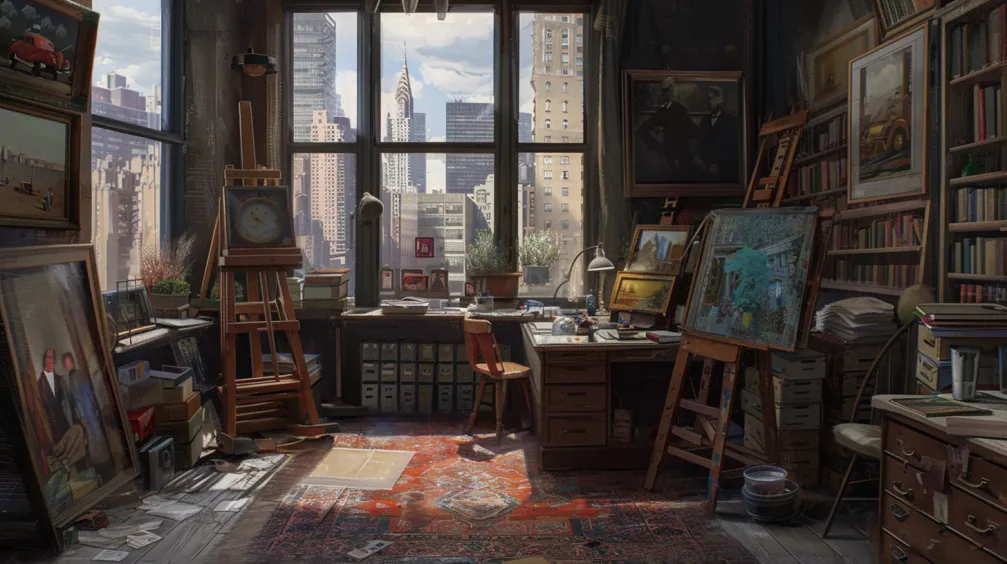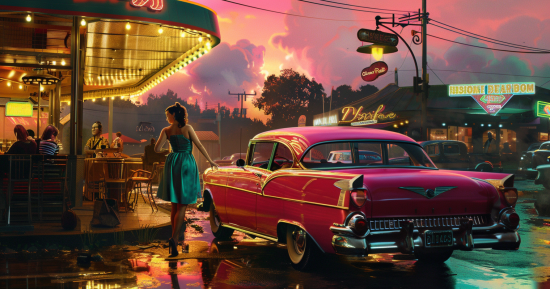Exploring the art of the 1920s unveils a vibrant time that marked a crucial transition in art history. During this period, artists defied conventional norms, resulting in the emergence of several significant art movements. These movements played a key role in laying the foundation for contemporary and modern art as we know it today.
As you delve deeper into the captivating world of 1920s art, you’ll discover how the creative minds of this period laid the groundwork for many contemporary and modern art styles. So, immerse yourself in this rich era and enjoy the journey through the fascinating world of art in the 1920s.
Historical Context of the 1920s Style Art
Post-World War I Influence
After the end of World War I, the 1920s showcased a significant change in the world of art. Artists started to embrace new styles and techniques, rebelling against the conventional artistic traditions that were prominent before the war. This period laid the foundation for contemporary and modern art as we know it today. As a result of the war, the art world saw a shift in focus and the emergence of new movements which redefined the purpose of art, transforming what it meant to be an artist.

During this era, one of the most influential art movements was Art Deco. Originating in Europe and the United States, Art Deco took inspiration from representational forms and introduced clean, streamlined shapes combined with unusual and varied materials.
The Roaring Twenties
The 1920s, also known as the Roaring Twenties, was a period of opulence and extravagance which greatly influenced art and architecture. This exciting era celebrated artistic expression and introduced an array of artistic styles that were seen as modern and even futuristic due to their innovative designs.
Some distinctive characteristics of 1920s style art were as follows:
- Bold colors and geometric patterns: Artists favoring Art Deco made use of vibrant shades and intricate patterns to create eye-catching designs.
- Streamlined shapes: The influence of the Roaring Twenties and the Art Deco movement led to simpler forms and a more streamlined appearance in art.
- Variety of materials: Artists expanded their range of materials, incorporating diverse materials like metals, glass, and plastics to create unique works of art.
1920s Style Art was truly a testament to the era’s rebellion against traditional norms, embracing the optimism and hope for progress that the post-war economy brought. The Roaring Twenties was a time when art and style took center stage, paving the way for future artistic innovations and leaving an indelible mark on the world of art and design.
Defining Characteristics of 1920s Art
The 1920s was an era of innovation and boldness in the world of art. Many styles began to emerge, each with its own defining characteristics. In this section, we will focus on three notable movements: Art Deco, Cubism, and Dada.

Art Deco
When you think of 1920s style art, the first thing that may come to your mind is the Art Deco movement. This trend in decorative arts and architecture celebrated simple, clean shapes, often with a streamlined look. It featured geometric or stylized ornamentation and made use of unusually varied materials.
Here are a few notable characteristics of Art Deco:
- Geometric shapes and patterns
- Stylized forms
- Streamlined appearance
- Rich colors and luxurious materials
Cubism
Another significant movement in 1920s art was Cubism which can be easily recognized by its unconventional shapes and angles. In this style, artists depicted objects from multiple viewpoints, breaking them down into simple geometrical shapes and reassembling them in a vivid composition.
Key features of Cubism include the following:
- Geometric shapes and fragmented forms
- Multiple viewpoints depicted simultaneously
- The use of simple, bold color palettes
- The fusion of various perspectives in a single image
Dada
Lastly, the Dada movement challenged conventional thinking in art and society, pushing the boundaries of what could be considered creative expression. This avant-garde art style emerged in response to World War I, aiming to challenge the status quo and reflect the absurdity of life through its creations.
A few noticeable Dada characteristics are:
- Nonsensical and/or absurd imagery
- Use of unconventional materials or techniques
- Satirical or cynical commentary on society
- Emphasis on chaos, unpredictability, and spontaneity
As these three styles – Art Deco, Cubism, and Dada – demonstrate, 1920s art truly encompasses a diverse range of approaches, materials, and ideas.
Notable Artists and Works
Famous Painters
During the 1920s, many talented painters emerged and pushed the boundaries of art. One such painter was Pablo Picasso, whose work in Cubism influenced an entire generation of artists. His Three Musicians painting remains a prime example of 1920s style art. Another prominent painter was Georgia O’Keeffe, an American artist renowned for her exceptionally detailed paintings of flowers and landscapes, like her Red Canna painting.
Additionally, Salvador Dalí began his artistic journey in the 1920s and became a leading figure in Surrealism. His early work, such as The Basket of Bread, showcased his fascination with the subconscious.
Influential Sculptors
Sculpture in the 1920s was also groundbreaking, led by key artists who had a significant impact on the art world. The renowned French sculptor Constantin Brâncuși revolutionized modern sculpture with his minimalist and abstract forms. His piece, Bird in Space, demonstrates the essence of the era’s artistic transformation.
Moreover, the American sculptor Alexander Calder gained recognition for his innovative mobile sculptures in the 1920s. Calder’s early works, such as the wire portrait of Josephine Baker, were a precursor to his later iconic kinetic sculptures.
Iconic Art Pieces
The 1920s saw the creation of several iconic art pieces that captured the spirit and energy of the time. The Persistence of Memory by Salvador Dalí, though officially created in 1931, remains one of the most famous artworks from the period, symbolizing the transition from the 1920s to the 1930s. Other notable works include Marc Chagall’s poetic painting, I and the Village, and Amedeo Modigliani’s striking piece, Reclining Nude on a Blue Cushion.
These artists, sculptors, and their compelling works profoundly shaped not only the art scene of the 1920s but also the development of modern and contemporary art worldwide.
Influence on Modern Art

Contemporary Styles
The 1920s played a significant role in shaping modern art, with artists of that era experimenting with various styles and techniques. This period saw a rebellion against traditional pre-war artistic conventions, opening up doors for new forms of expression. For example, Impressionism introduced the use of non-naturalistic colors in portraying subjects, serving as a major influence on modern artists.
Legacy in Design
As a result of these artistic innovations, the 1920s art scene left an indelible mark on modern and contemporary styles. So, when you encounter various forms of art today, remember the influential role played by the artists and movements of the 1920s in shaping the creative world that surrounds us.
Collecting 1920s Art
The 1920s represented a transformative period in the art world. As a collector, you can focus on exploring and acquiring pieces that showcase the revolutionary styles and movements emerging during this time. Here are some ideas on how to go about collecting 1920s style art.
Art Market and Auctions
The art market is vast, and the best way to start your journey as a collector is by researching the various options available to you. One way is to attend art auctions and galleries specializing in 1920s style art. Here, you can discover works from notable artists such as Pablo Picasso and René Magritte. Keep an eye on auction houses, as they occasionally offer pieces from this era.
Some renowned auction houses to consider:
The Internet offers further opportunities to gain access to regional art markets.
Preservation and Curation
Once you have acquired a piece of 1920s art, taking care of it is vital to ensure its value and significance are preserved. Here are some tips on preserving and curating your 1920s art collection:
- Proper Storage: Store your artwork in a climate-controlled environment, avoiding exposure to excess humidity, heat, or sunlight.
- Framing: When framing your art, choose high-quality materials like acid-free matting and UV-protective glass to prevent damage.
- Documentation: Keep a comprehensive record of your collection, including purchase receipts, provenance, and any restoration or conservation work.
Incorporating your collection into your living space is a fantastic idea, but be cautious about exposure to harmful environmental factors. Creating a dedicated space to showcase your 1920s style art can not only enhance your home’s aesthetics but also emphasize the cultural importance of this period, as art from the 1920s played a vital role in shaping modernism and contemporary art.
By immersing yourself in the 1920s art world and taking care of your collection, you can enjoy the captivating pieces from a crucial era in art history while preserving their significance for future generations to appreciate.
Do you already have experience with 1920s art? Let us know via the comments.
What made the 1920s modern?
The 1920s were modernized by significant societal and cultural shifts, including technological advancements, the rise of mass media, changing social norms, and the flourishing of artistic movements such as Art Deco and Modernism, all contributing to a dynamic and transformative era.
What is an example of Art Deco in the 1920s?
The Chrysler Building in New York City is a prominent example of Art Deco architecture from the 1920s. Its sleek, geometric design, intricate ornamentation, and use of materials exemplify the distinctive style of the era.
What was popular in the 1920s?
In the 1920s, jazz music, flapper fashion, Art Deco design, and the Harlem Renaissance were popular. Prohibition and speakeasies also defined the era, along with technological advancements, the rise of mass media, and the flourishing of modernist art and literature.






